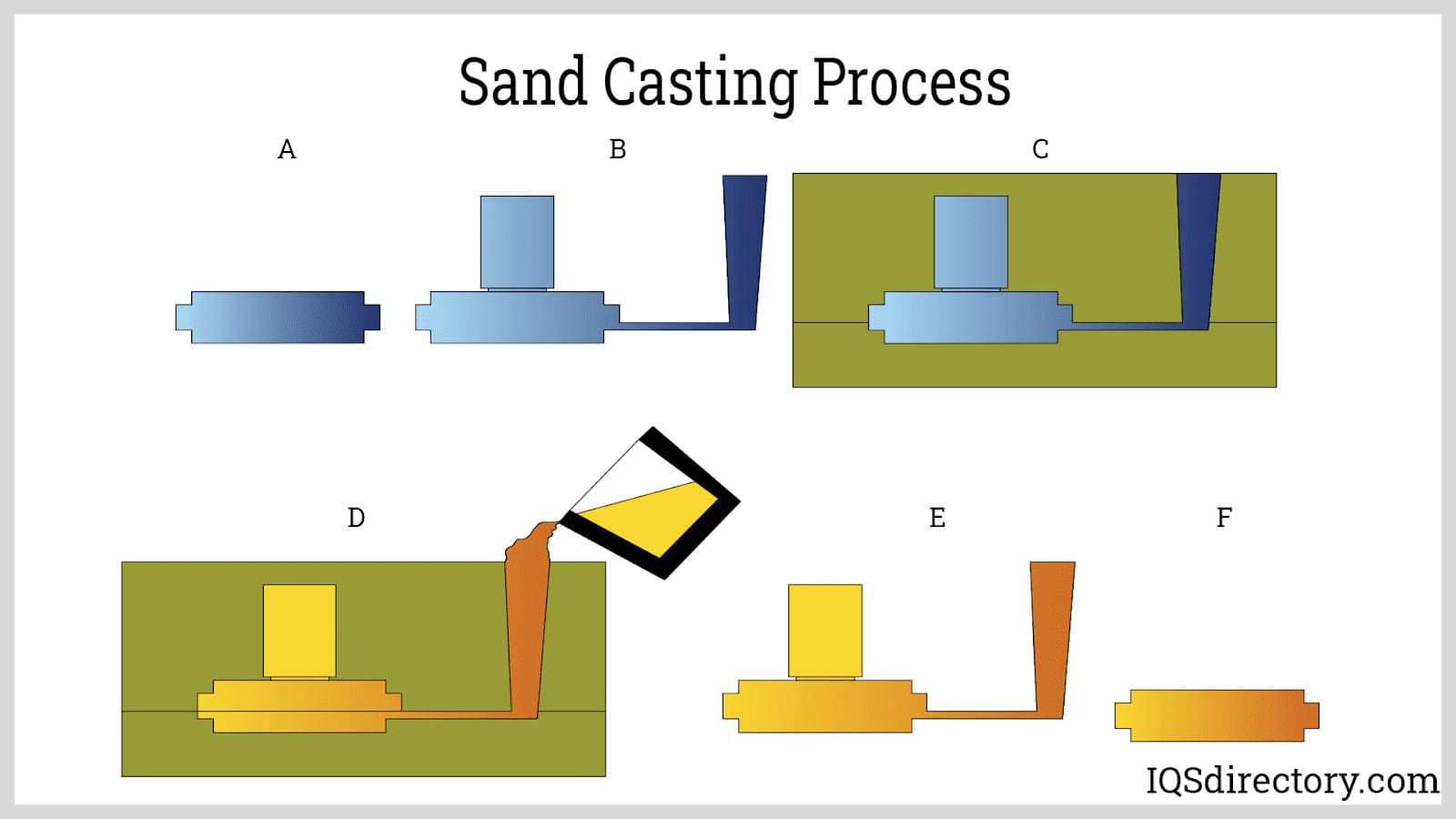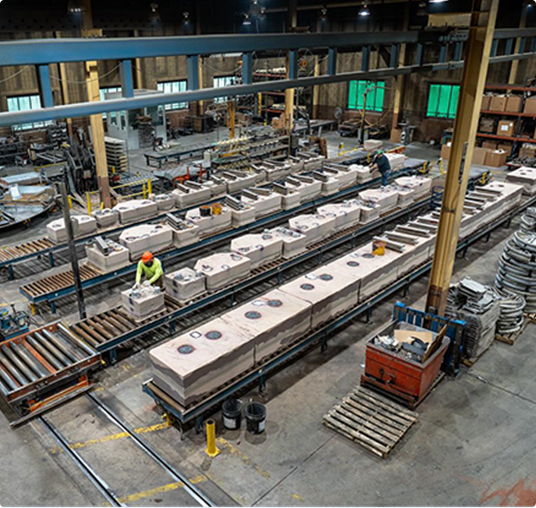Checking Out the Diverse Applications and Advantages of Aluminum Foundry in Modern Production
Aluminum shops are necessary in today's production landscape. They produce elements that serve various markets, including automotive and aerospace. The light-weight nature of Aluminum incorporated with its toughness makes it a favored option. Additionally, cutting-edge casting techniques boost production effectiveness. The implications of these innovations on sustainability and future patterns necessitate more exploration. What possibilities and obstacles lie ahead for Aluminum shops in this developing market?
The Role of Aluminum Foundries in Modern Production
Aluminum foundries play a necessary role in modern-day production, contributing markedly to numerous markets such as automobile, aerospace, and building. These centers specialize in the melting and casting of light weight aluminum, a lightweight, sturdy material recognized for its superb corrosion resistance and thermal conductivity. The shops utilize sophisticated techniques, including sand spreading, die spreading, and investment spreading, to produce top notch components tailored to details applications.
Key Applications of Aluminum Components Across Industries
Throughout numerous industries, Aluminum elements are indispensable to enhancing performance and performance. In the automobile industry, Aluminum is extensively used for engine blocks, transmission situations, and structural elements, adding to lighter vehicles that enhance gas performance. The aerospace industry relies on Aluminum for aircraft wings, elements, and structures, capitalizing on its high strength-to-weight proportion to boost trip performance.
In electronic devices, Aluminum is used in heat sinks and housings, offering efficient thermal administration while keeping lightweight qualities (Aluminum Castings). The building market advantages from Aluminum in window frameworks, roof, and cladding, where durability and aesthetic appeals are necessary
In addition, product packaging applications utilize Aluminum for aluminum foils and canisters, supplying a reliable barrier against wetness and light. In each of these industries, Aluminum components not only sustain useful needs yet likewise advertise sustainability with recyclability, making them a favored choice in modern-day production methods.

Advantages of Aluminum Compared to Various Other Materials
The versatility of Aluminum makes it a remarkable option over many various other materials in producing applications. One of its key advantages is its light-weight nature, which adds to decreased energy intake and improved effectiveness in transportation and construction markets. In addition, Aluminum displays superb corrosion resistance, boosting the long life of products without the demand for comprehensive maintenance.
Light weight aluminum's pliability permits for complex layouts and shapes, providing to varied market demands, from automotive to aerospace. Its electrical and thermal conductivity likewise surpasses that of numerous choices, making it suitable for applications calling for heat dissipation or electrical transmission.
Moreover, Aluminum is highly recyclable, promoting sustainability in producing procedures. Compared to steel, it offers a favorable strength-to-weight proportion, permitting robust yet lightweight frameworks. Jointly, these qualities setting Aluminum as a preferred product, allowing makers to achieve both performance and sustainability in their products.
Ingenious Casting Methods in Aluminum Foundries
In the domain of Aluminum production, cutting-edge casting strategies are reinventing the production process and boosting the material's applications. Amongst these methods, pass away spreading stands apart for its capacity to create complicated forms with high accuracy and very little waste. This method enables fast mass manufacturing, making it suitable for markets such as automobile and electronic devices. In a similar way, financial investment spreading has obtained popularity due to its capability to develop elaborate layouts with outstanding surface area finish, accommodating both huge and little elements.
Another remarkable strategy is sand spreading, which offers convenience and cost-effectiveness for creating majorities. Recent advancements in 3D printing modern technologies are likewise being incorporated right into Aluminum spreading, enabling fast prototyping and modification. These developments not only boost performance but also expand the opportunities for Aluminum applications throughout various fields, ultimately driving the advancement of contemporary production methods.
Sustainability Efforts in Aluminum Production
Sustainability initiatives in Aluminum manufacturing concentrate on improving recycling processes, which greatly decrease power intake and discharges. Carrying out energy effectiveness practices even more adds to a lowered carbon footprint, making Aluminum a more ecologically pleasant product. These initiatives mirror the market's dedication to lasting manufacturing and source preservation.
Reusing Aluminum Benefits
While Aluminum production is resource-intensive, recycling Aluminum provides substantial advantages that straighten with sustainability campaigns in manufacturing. Recycling Aluminum needs only 5% of the energy required for primary manufacturing, considerably minimizing greenhouse gas emissions. This energy performance not only conserves natural sources but also lessens the environmental impact related to mining and refining raw products. In addition, recycling Aluminum supports a round economic situation by reintroducing products back right into the supply chain, consequently look at this website reducing waste and advertising source conservation. The procedure additionally generates financial benefits with work production in reusing facilities and reduces reliance on foreign Aluminum sources. In general, recycling Aluminum is a vital component of sustainable practices that add to a more environmentally liable production landscape.
Power Efficiency Practices
The Aluminum production market is progressively adopting power effectiveness techniques to boost sustainability together with recycling initiatives. These initiatives concentrate on maximizing energy consumption throughout the manufacturing procedure. Makers are carrying out innovative innovations such as high-efficiency furnaces and wise grid systems, which enable far better power management and decreased waste. Furthermore, the assimilation of renewable resource resources, like solar and wind power, is coming Homepage to be extra common, in addition lowering dependence on nonrenewable fuel sources. Continuous surveillance and evaluation of power usage assist in the recognition of ineffectiveness and opportunities for renovation. Furthermore, labor force training on energy-saving methods assurances that workers proactively add to power conservation initiatives, developing a culture of sustainability within the organization. These methods jointly support an even more sustainable Aluminum production landscape.
Lowered Carbon Impact
To achieve a decreased carbon impact, the Aluminum manufacturing sector is significantly embracing ingenious sustainability initiatives. Companies are purchasing innovative innovations that decrease power consumption and emissions throughout the production procedure. The assimilation of sustainable energy resources, such as solar and wind power, plays a critical role in decreasing dependence on fossil gas. In addition, the recycling of Aluminum scrap substantially decreases the carbon footprint, as recycled Aluminum calls for just a portion of the power needed for key manufacturing. Joint efforts among producers, federal governments, and environmental organizations better drive progress in sustainability. By embracing these procedures, the Aluminum market not only addresses environmental issues however also boosts its one-upmanship in a market increasingly focused on eco-friendly practices.
Future Patterns in Aluminum Foundry Innovation
Innovation is at the leading edge of Aluminum Foundry technology, driving substantial improvements and improving industry practices. Arising fads consist of the integration of artificial knowledge and artificial intelligence, improving procedure optimization and top quality control. These innovations promote anticipating upkeep, reducing downtime and enhancing operational effectiveness. Furthermore, making use of 3D printing and additive production is getting traction, permitting for complicated geometries and lowered product waste.
Sustainability remains an essential emphasis, with developments in reusing methods enhancing the circular economic climate of aluminum. Business are progressively embracing energy-efficient techniques, such as low-pressure die spreading, which reduce power usage and exhausts. Furthermore, electronic twins are becoming commonplace, enabling real-time surveillance and simulation of Foundry processes.

Regularly Asked Inquiries
What Security Steps Are in Place at Aluminum Foundries?
Aluminum shops implement various safety actions, consisting of protective gear, appropriate ventilation, fire avoidance systems, routine security training, and emergency situation procedures to reduce risks connected with heats, molten metal handling, and prospective exposure to dangerous products.
How Do Aluminum Foundries Guarantee High Quality Control Throughout Manufacturing?
Aluminum shops implement rigorous quality assurance procedures such as regular inspections, material screening, and adherence to sector requirements. These procedures assure consistency in products while lessening defects, eventually improving the integrity and performance of Aluminum components.
What Are the Common Difficulties Encountered by Aluminum Foundries?
Aluminum foundries commonly deal with difficulties such as maintaining regular high quality, taking care of manufacturing prices, guiding regulatory compliance, attending to equipment maintenance issues, here are the findings and adapting to varying market needs, all of which can impact functional efficiency and profitability. - Aluminum Foundry
Just how Does the Aluminum Recycling Refine Operate In Foundries?
The Aluminum recycling process in foundries involves gathering scrap light weight aluminum, melting it in furnaces, getting rid of pollutants, and casting the liquified steel into desired forms, thereby reestablishing it into the manufacturing cycle efficiently and sustainably.
What Are the Task Opportunities Available in Aluminum Foundries?
Task chances in Aluminum foundries include duties such as Foundry drivers, top quality control assessors, upkeep service technicians, engineers, and manufacturing managers. These positions need different ability degrees, providing possible for job improvement within the production field.
Sustainability initiatives in Aluminum manufacturing emphasis on enhancing reusing processes, which considerably decrease energy intake and emissions. While Aluminum manufacturing is resource-intensive, reusing Aluminum presents substantial benefits that line up with sustainability campaigns in production. Recycling Aluminum needs just 5% of the energy needed for key production, considerably minimizing greenhouse gas exhausts. The Aluminum production industry is increasingly embracing energy performance practices to boost sustainability along with recycling initiatives. In addition, the recycling of Aluminum scrap considerably decreases the carbon impact, as recycled Aluminum requires just a portion of the energy needed for primary production.